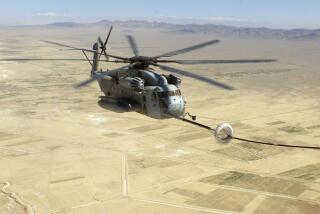Bit of Navy History Is Found Intact on Sea Floor Off S.D.
Although searching the ocean floor for a downed helicopter 9 miles off the San Diego coast last fall, sailors found a rare F-3 biplane, a pre-World War II fighter that crashed 50 years ago, the Navy said Monday.
Though a civilian model is now housed in the Smithsonian Museum, this plane is believed to be the first military F-3 aircraft to survive the years, said Senior Chief Bob Howard, spokesman for the Pacific Fleet Naval Air Force.
âThis is a real find,â Howard said. âThe pilot settled it down on the water, then it sunk. Youâve got this gorgeous old plane sitting down there in marvelous condition.â
The plane was piloted by then-Lt. Robert Edward Galer, now 76 and a Dallas resident, who was not hurt in the crash. Galer later won the Medal of Honor for leading his squadron to shoot down 27 Japanese planes during World War II. In Oct. 1942, Galer--a member of Marine Unit 223 that was dubbed the âFlying Foolsâ--downed 11 enemy bomber and fighter aircraft.
As Galer, who retired from the Marine Corps as a brigadier general, looks back on his 23 years of service, he is almost nostalgic about the F-3 crash, which he believes prepared him for being shot down several times in combat.
âThe biplane is very nice to fly--itâs very stable, though itâs not very fast,â said Galer. âAnd itâs very forgiving. You could make a mistake and still recover.â
But on Aug. 29, 1940 at 12:30 p.m., Galer made no mistake. Two pilots had reported having trouble aboard the aircraft. The engineering crew on the aircraft carrier Saratoga believed they had fixed the ill-fated plane and Galer was assigned to try it out.
After taking off, he checked the fuel tanks several times, according to an accident report filed after the crash. Galer took off using the reserve fuel supply and flew several minutes before attempting to switch to the auxiliary fuel supply. As he tried to switch from one tank to another, the engine began to sputter, according to the report. Still switching from tank to tank, Galer realized he was in trouble and gave the forced-landing signal. At about 1,000 feet, he was able to hold to the landing pattern.
âI had gone through all the procedures, and it would not re-start. I had been flying long enough and seen enough planes go down that it wasnât a complete surprise,â Galer said. âI figured I would make a smooth landing in the water and the destroyer would pick me up. Youâre too busy to be afraid.â
As Galer struggled, another pilot--Marine LtN. Endweiss--spotted black smoke coming from Galerâs plane. Unable to help, Endweiss watched as Galer smacked into the water. Circling in the air, he waited to see Galer, who signaled that he wasnât hurt.
âIt was typical San Diego water--it was very nice,â said Galer, who hit the water about 300 yards astern of the carrier.
At the time of the crash, the biplane had 16 gallons of fuel. It stayed afloat five minutes before sinking. On Oct. 31, the Navy gave up on the plane and struck it from their records as lost.
And it stayed on the sea bottom. Last fall, a deep submergence vehicle, called a âturtle,â stumbled upon the airplane as sailors were conducting routine operations and searching for a helicopter that had crashed in October, claiming two lives.
Navy officials expect to pluck the plane from the water during early April, after they retrieve the sunken helicopter. The plane will be taken first to North Island Naval Air Stationâs Naval Depot for preliminary rehabilitative work and then to San Diegoâs Air and Space Museum for further attention. Eventually, it will be housed in the Naval Air Museum in Pensacola, Fla., Howard said.
During 23 years in the Marines, Galer was shot down three times during World War II and another time in Korea.
Counting the ocean landing near San Diego, âthat makes five times, and my son says that makes me an ace,â joked Galer, laughing.
More to Read
Sign up for Essential California
The most important California stories and recommendations in your inbox every morning.
You may occasionally receive promotional content from the Los Angeles Times.










